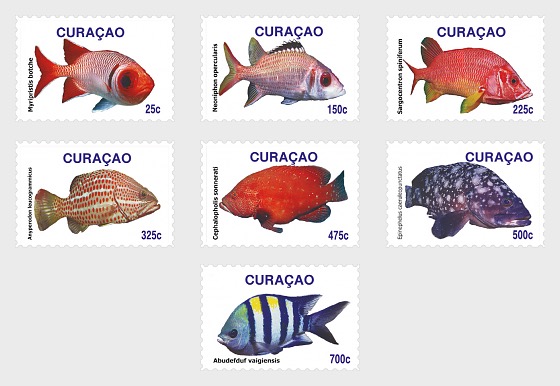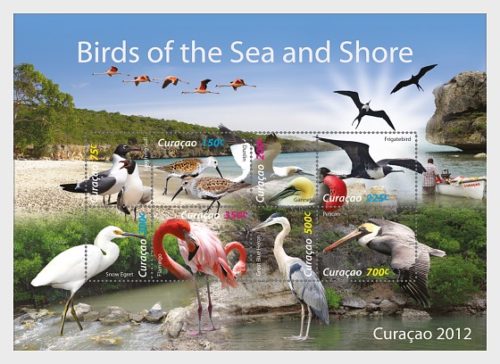Description
Fishes have several meanings in our daily lives. Throughout history fishes has been associated with religion. They have used fish to symbolize Life and Spirituality. Fish is also often mentioned in the gospels. We know also that fish,contains proteins and healthy fats that will improve your health. Fish is also a source of labour (income). Nieuwe Post with this 7 stamps emission wants to emphasize, the importance of fishes.
25c stamp Myripristis Botche
Also called Blacktip soldierfish. Front of head red; postorbital head and body silvery white, edges of scales red; spinous dorsal whitish on basal half, red on outer half; median fins red with white leading edges, the lobe tips with a large black spot; paired fins whitish. Soft dorsal, anal and caudal fin with bright white margins and black areas at the tips. Inhabits protected waters at depths greater than 25 m, often in silty reef areas than well developed coral reefs with clear water.Tends to hide in caves or crevices during the day. Usually seen in pairs, but occasionally schools in some oceanic locations..
150c Stamp Neoniphon Opercularis
Body iridescent silvery with dark red or black mark on each scale. Spinous portion of dorsal fin black; soft dorsal, anal and caudal fins reddish yellow; pectoral fins pink, pelvic fins white . Lower jaw strongly projecting. Inhabits subtidal reef flats and lagoon and seaward reefs to depths of at least 20 m. Found singly or in small groups in coral-rich areas Feeds mainly on benthic crabs and shrimps. Large spine at the corner of preopercle is venomous. It raises or flashes its distinctly marked dorsal fin to startle possible predator.
225c Stamp Sargocentron Spiniferum
Sargocentron spiniferum is a genus of squirrelfish containing approximately 35 species. They are found in tropical parts of the Indian, Pacific and Atlantic Oceans, with the greatest species diversity near reefs in the Indo-Pacific. Being largely or entirely nocturnal, they have relatively large eyes. Red and silvery colours dominate. The preopercle spines (near the gill-opening) are venomous, and can give painful wounds. S. spiniferum can reach approximately 50 cm. Head and body red, scale edges silvery white; spinous dorsal crimson in color; other fins orange-yellow; vertically oblong crimson spot on preopercle behind eye and five oblique scale rows on cheek.
325c Stamp Anyperodon leucogrammicus
Anyperodon leucogrammicus is a reef-associated, non-migratory species that inhabits coral rich area and clear waters on lagoon and seaward reefs. It is an Indo-Pacific species. Anyperodon leucogrammicus is widespread, but not abundant. Global warming may well affect the abundance and distribution of the species.
475 c Stamp Cephalopholis Sonnerati
The Tomato Rockcod is a deep bodied species with a hump-headed appearance. It is red to orange-red or brown, sometimes with brown, red or white spots. It grows to about 58 cm in length. the species occurs in the Indo-West and Central Pacific regions. In Australia it is known from tropical waters from the central coast of Western Australia to southern Queensland. Feeds on small fishes and crustaceans including shrimps, crabs and. Opercular spines very small. Pelvic fins usually reaching or extending beyond anus. It is a benthic species that occurs in coral reef and tropical inshore waters at depths from about 30 m to 100 m.
500 c Stamp Epinephelus coeruleopunctatus
Whitespotted Grouper. Often confused and sold as E. ongus, E. summana, E. corallicola. Thirty inches in length in the wild. Has a temperature range of 72 – 82°F (22 – 28°C) and their natural diet consists mainly of small fishes and crustaceans. Requires a meaty diet, i.e., chopped fish and/or shrimp flesh, and two feedings per week. Prefers to be fed in late afternoons or early morning hours. Too large for most hobbyist systems. Best left in the wild.
700c Stamp Abudefduf Vaigiensis
The Indo-Pacific Sergeant has a white body with five black bars. The upper part of the body usually has a yellow tint. The tail is unmarked, unlike the similar Scissortail Sergeant which has a black stripe along each lobe of the tail. Other Names Common Sergeant, Five-banded Damsel-fish, Five-banded Sergeant-major. Size to 20cm. Habitat inshore waters, coral reefs. Food algae, plankton. The Indo-Pacific Sergeant is found in waters of the Indo-Pacific and Central Pacific.




